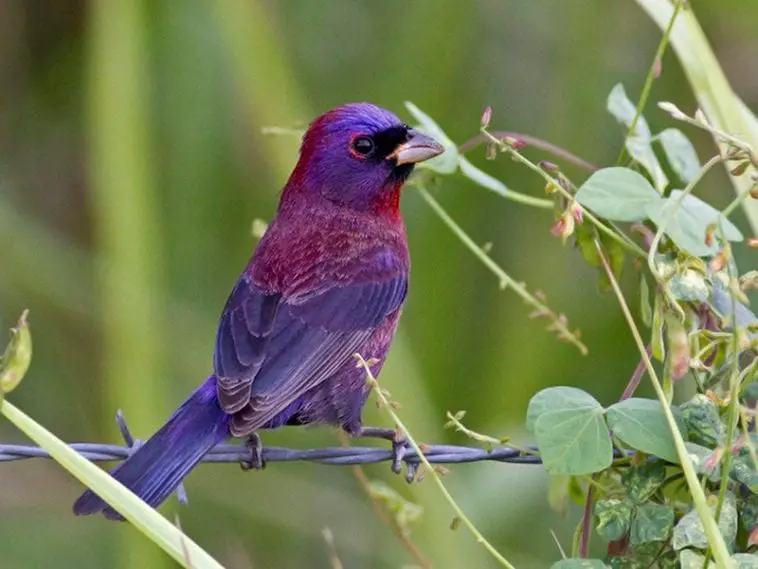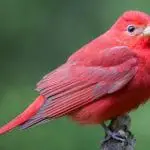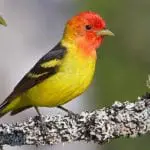Scientific Facts
| Common Name | Varied Bunting |
| Scientific Name | Passerina Versicolor |
| Length | 4.3 to 5.5 inches |
| Clutch Size | 2 to 5 eggs |
| Habitat | Brushy Woodlands |
| Country of Origin | United States |
Physical Description
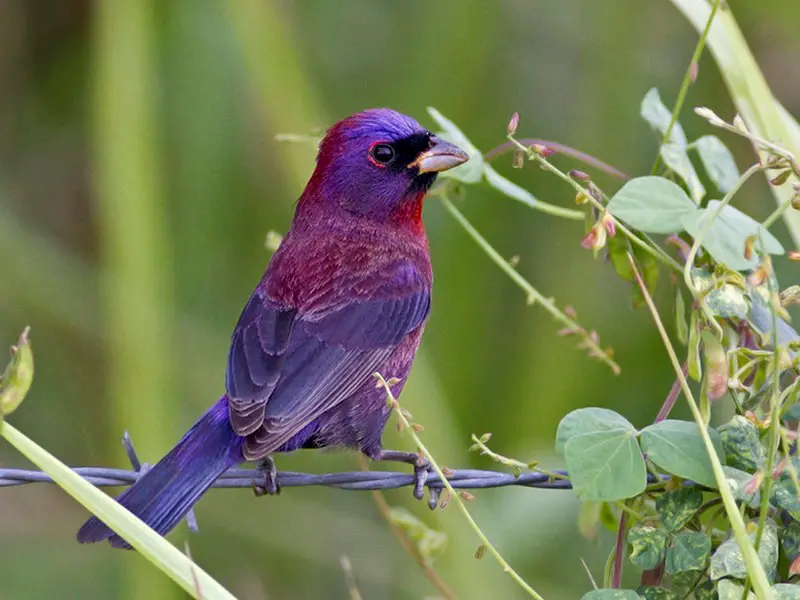
Varied buntings are birds that feature beautiful colors. At a distance, they look seemingly dull and dark. The male buntings feature a gorgeous color pattern up close. They have a red throat and nape, with a brilliant blue forehead. They also have a purplish cheek, with red arcs just behind their eyes. Their body is rich purple in color with a blue rump.
Female buntings are quite plain. They feature a medium-brown, warm color with few markings. They have plainer belly and wings, with a curved bill top. Females resemble female indigo buntings, but without the streaks on their breast. These birds are stocky, with a rounded bill and a short tail. They are usually 11 to 14 centimeters or 4.3 to 5.5 inches in length. Their wingspan is at 21 centimeters, with a weight of 11 to 13 grams.
Similar to painted buntings, male varied buntings look like jewels in appearance. They feature brilliant colors that stand out amidst their arid habitat. Despite their obviously striking appearance, varied buntings are inconspicuous birds, usually hidden in desert brush, and typically far from human habitation. Since these buntings hide in dense cover, they are very easy to find when they sing their series of whistled, sweet phrases, similar to their closely related Lazuli and Painted Buntings.
Distribution
Even though varied buntings are common in Mexico, their population in Texas is locally uncommon, even rare. Their population has greatly decreased since the 1870s, at least in certain regions in Texas. In the southeastern part of Arizona, varied buntings are considered as locally common species for breeding within their nesting season of early July to early September. This also coincides with the season for summer rainfall. In the state of Arizona, the breeding habitat of varied buntings have been degraded instead of destroyed, possibly accounting for the difference in the population and abundance between these two states.
Researchers have confirmed that there is evidence of breeding among varied buntings in three areas, the Big Bend, the Edwards Plateau, and the lower part of the Rio Grande Valley. On top of that, there is also an additional 23 probable locations, with 15 possible records of these locations. These buntings also breed in New Mexico and Southern Arizona, as well as most of mainland Mexico. The buntings that breed in the United States, as well as the highlands of northern Mexico, usually move south or towards lower elevations in winter.
Seasonal Occurrence
The migration of varied buntings in spring usually happens between April and June, with most of them arriving from mid-April to mid-May. The breeding season of these buntings in Texas usually extends from mid-April to mid-July, depending on egg dates within April 26 and July 7. The movement towards the south usually happens from June 10 to September 6, with their peak happening within mid-July to late August.
Breeding Habitat
Varied buntings are observed to breed in Texas from close to sea level, up to a height of 1600 m, along with the thorny brush, dense, and generally sloping areas with an arid climate. In the state of Arizona, this species breeds along intermittent and perennial streams in vegetation, ranging from cottonwood, sycamore, willow, ironwood and mesquite paloverde. The nests are usually placed in a bush, low tree, or vine tangle, in a compact cup made of small forb stems, dry grass, and soft materials, usually lined with fine grasses and rootlets.
Feeding and Diet
These birds forage at various levels, from the ground up, into trees and shrubs. They also take insects from the leaves, berries from shrubs, and seeds from the ground. They typically forage alone in summer, even though they are also observed to gather in smaller flocks in wintertime.
The diet of varied buntings is poorly known. During the breeding season, they feed mostly on insects, berries, and seeds. Food is being brought to young at their nest, with mostly insects comprising their diet. During winter, their diet probably includes more seeds.
Habitat and Range
They are usually found in brushy woodlands and clearings. These birds prefer brushy habitats with steep slopes, particularly desert washes and riparian areas. They are found throughout most regions in Mexico, reaching as far as the northern limits of their range in the borders of Texas, New Mexico, and Arizona. Small populations are also found in Chiapas, Mexico, as well as in the southeastern part of Guatemala.
The brushy countryside close to the Mexican border serves as a summer home for these elegant, varied buntings. The thorny and dense nature of its habitat may make it quite challenging to approach. The birds, however, are not really shy. At times, they can be watched at really close range.
Interesting Facts
Here are some interesting facts about the Varied Bunting:
- A group of varied buntings is known collectively as a “mural,” “decoration,” and “sacrifice” of buntings.
- Varied buntings are distributed unevenly. They are also inconspicuous, which is why very little is known about them.
- Eggs are typically polymorphic in color among their populations. This is quite a rare phenomenon among passerine bird species.
- These birds typically spend most of their time hidden in dense desert brush, only surfacing when the males start to sing from the top of a bush.
Behavior
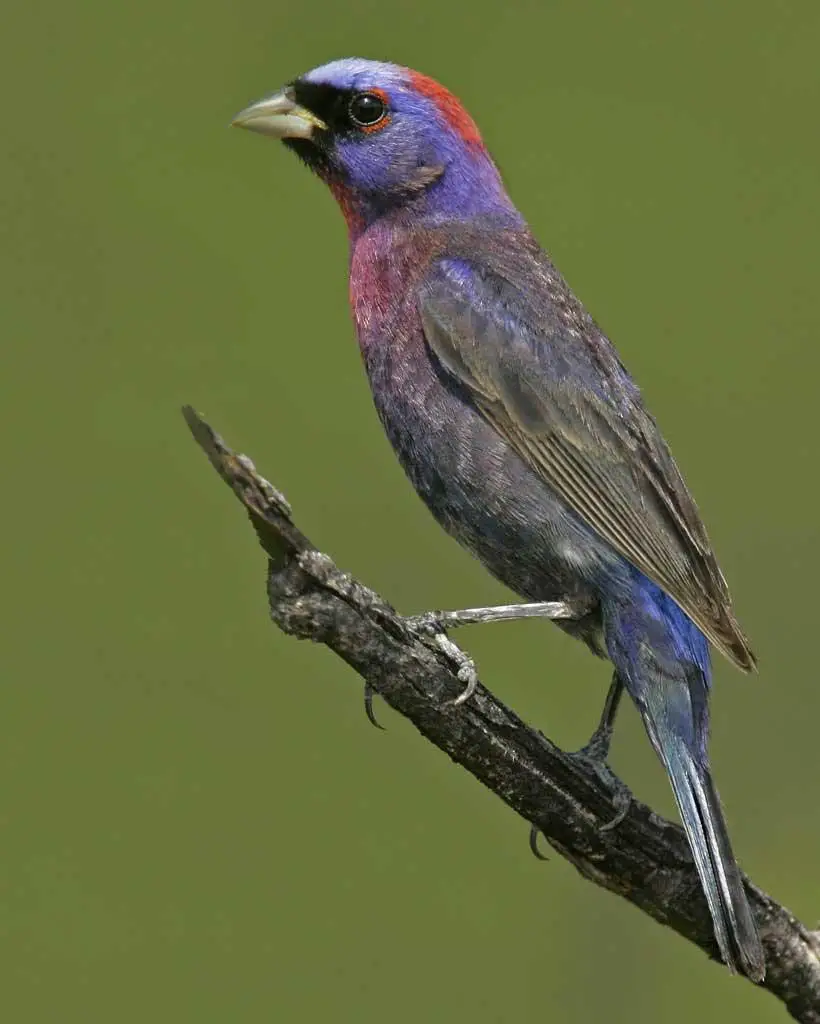
Varied buntings have a unique pattern of migration and molt. Individual birds start their prebasic molt around late summer, typically on their breeding grounds. Afterward, they interrupt this molt to migrate to one of their molting hotspots, which include New Mexico, and Southern Arizona. There, they finish their molting before starting their migration to the wintering grounds of Western Mexico.
The males of the varied bunting species are highly territorial. They are also quite aggressive with each other. It is common to see fights between males, which typically include beating with wings, pecking, and grappling. These fights can even become very serious that they could sometimes result in death.
Varied buntings were formerly placed in their own genus, Guiraca. There are similarities with buntings in terms of molts, behaviors, and plumages, leading to their inclusion in the bunting genus Passerina. There has been genetic evidence indicating that Lazuli Buntings are their closest relatives.
The sequences in the notes of their songs are unique in local neighborhoods. Male buntings that are located just a few hundred meters apart usually have different songs. The males on the neighboring territories usually have the same or almost identical songs. This is a behavior that is also similar to male Lazuli buntings.
Molting
Just like with other bird species, male varied buntings do not enter molting into full adult plumage until they reach their second year in life. These birds work quite hard in order to maintain their features. As such, they preen them daily. Since feathers eventually wear out, most birds replace their feathers with a fresh coat at least every year. This process is being referred to as molting. With some bird species, including the varied bunting, birds change colors completely during a molt, from their winter feathers to their signature breeding plumage.
Breeding
Female varied buntings usually lay two to five bluish-white to bluish-green eggs, which are then being incubated for around 14 days. The young buntings become fully feathered after 10 days. Afterward, they become ready to leave their nest after several days more.
The young are fed by both parent buntings. For a few days right after their fledging, the brood may split, with two young going with females, and the other two with males. The males may then take over the act of caring for all the young while the female buntings start to attempt another nesting. Usually, they produce two broods every year, and at times, three.
Nesting usually happens in late summer, especially in Arizona, after the start of summer rains. In Texas, they do so in early summer. Male buntings usually defend their territory by singing, along with some fluttering flight display that is directed towards intruding males. The nesting sites are usually found in low trees, dense shrub or vine, usually two to five inches above the ground, even reaching as high as 12 inches. The nest is usually built by both parents, with a compact open cup, mostly using weeds and dry grass, lined up with finer materials.
Conservation Status
Varied buntings are still locally common in the Southwestern part of the United States, even though some habitat has been lost. They may be possibly declining in some parts of their range in Mexico, as overgrazing of animals, such as goats, degrades their habitat.
There are little details involving the population trends of varied buntings. It has been estimated that a global breeding population of this species is at 2 million, with 99% spending part of their year in Mexico, while the other 1% are breeding in the United States. For this reason, varied buntings are not on the State of Birds Watch List in 2014.
These beautiful buntings are described as a common cage bird in Mexico. Among the problems that control their population includes mining, agriculture, urban development, as well as other human uses, which ultimately pose a threat to their population.
Migration
Most varied buntings leave the United States in winter, possibly moving only a short distance towards the south into Mexico. They have also been discovered recently wintering in smaller numbers in the Big Bend area of Texas.
Bird Feeder Care
If you decide to keep varied buntings at home, making sure that feeders are kept clean is very important. This means that the feeders need to be regularly cleaned using warm water and completely dried before refilling with fresh seed. If debris or mold has accumulated or you have observed sick birds in the feeder, ten parts of water to one part of the bleach solution can be used to clean the feeder. Rinse it well and dry it completely before refilling it with fresh seed.
Wooden feeders fade through the years naturally. It is not a necessity to treat wood feeders using any products. However, if you want to maintain the appearance of a wooden feeder, you can do so in the right way. Cedar or redwood feeders are used widely for outdoors due to their excellent weathering features, which are found naturally in the wood as it grows. When used under normal conditions, they remain functional for several years without any maintenance. Pine feathers weather quite well though they fade through time. To help maintain them, apply a water-soluble stain or linseed oil every few years as required.
There are also some benefits of using copper feeders. Copper adds color and warmth, which cannot be easily duplicated using other types of metal. For one, it is corrosion-resistant. Note, however, that copper can rapidly discolor to pale green if nothing is done in order to preserve its color. In order to restore the luster of your feeder, polish the copper using a copper varnish or cleaner. Seal the copper using clear lacquer. There are also tube feeders that can be used, and come with armored feeding stations and seed deflectors which ensure that all of the seeds are eaten, and does not stay at the bottom of the feeder.
FAQs
What is a group of varied buntings called?
A group of varied buntings is called a “decoration,” “sacrifice,” and “mural.”
Where do varied buntings nest?
Varied buntings nest in low trees, dense shrubs or vines, usually two to five inches above the ground, even reaching as high as 12 inches. The nest is usually built by both parents, with a compact open cup, mostly using weeds and dry grass, lined up with finer materials.
When do varied buntings start nesting?
Varied buntings usually start nesting in late May or early June, though with the absence of summer rains, nest building may be delayed until August.

